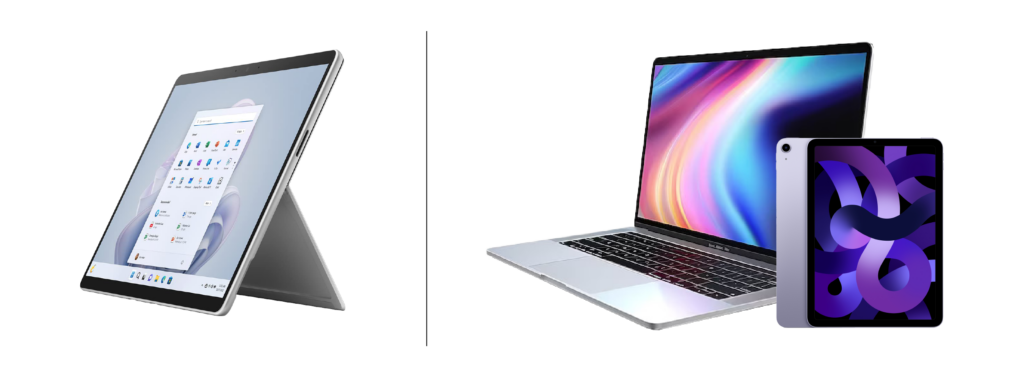Businesses understand the need to give their workers a frictionless experience that simplifies their workflows and increases productivity. This need is especially important for modern, hybrid workers who shift between their homes, workplace offices, and company meeting rooms. It’s also a critical consideration for mobile workers who need to work from planes, hotels, or cafes while they’re on the go.
For these users, standard laptops might not cut it. Mobile and hybrid workers want the Swiss Army knife of computers: a device that offers flexible form factors, a touch screen, stylus support, and more.
With these needs in mind, we looked at two popular options to see which offered the best overall productivity and user experience, one based on Windows® and one based on Apple macOS®/iPadOS®:
- A Windows-based solution, using a Microsoft Surface® Pro 9
- An Apple ecosystem-based solution, using an Apple® MacBook® and/or Apple® iPad®
Form Factor and User Experience
Why two Apple devices? That’s because neither Apple device on its own can function as both a laptop and a tablet. MacBook Air® and MacBook Pro® devices are powerful, but they eschew a touch screen and can’t be used in tablet form for reading, sketching, or note-taking. iPad, iPad Air®, and iPad Pro® devices are useful tablets that support reading, sketching, and note-taking, but they do not run the full-featured apps available on MacBook or Windows devices.
In contrast, the Surface Pro offers a flexible form factor that can be used in both laptop and tablet mode, while running full-featured Windows apps in either mode. It also provides a touchscreen, and it supports handwritten notes with an optional stylus. Because this device is so adaptable, it is particularly appealing to mobile workers looking to maximize productivity throughout the workday on a single, flexible device.
For example, a sales representative on the go might start the day at the office using a Surface Pro in laptop mode, plugged into an external display. Later, while traveling to a sales call on a train or plane, they could disconnect the keyboard cover, hold the device vertically like a pad of paper, and use a stylus to mark up a diagram, sketch out ideas, or take hand-written notes.
And because the Surface Pro supports Windows, users can work with the full-featured business productivity apps that they are used to.
In comparison, a MacBook Air or MacBook Pro can provide good performance for business users, but it does not have a touchscreen or stylus support. To match the capabilities provided by the Surface Pro, users would need to separately purchase an iPad tablet because Apple does not provide one device that can offer this combined functionality.
To replicate the sales rep scenario above, the user would start out on a MacBook Pro at the office, but then would need to switch to an iPad to create hand-written notes and sketches or to read documents in tablet mode. Because the sales rep would be switching between the MacBook and iPad devices, they would need to rely on wireless syncing to see their changes reflected on the other device. Of course, that’s assuming they are using apps that have comparable versions on both devices, which isn’t a given, because (1) some macOS apps do not have iPad counterparts, and (2) when those counterparts exist, they might not have equivalent functionality.
Apple users looking for tablet functionality would likely require two devices—a MacBook Pro and an iPad Air—to achieve functionality equivalent to the Surface. That’s not only inconvenient, it means spending hundreds or thousands of dollars more.
Support and Management
Currently, Windows PCs are still the overwhelming choice for business users. Data from Statista shows the Windows operating system (OS) with a market share of more than 73 percent, compared to about 15 percent for macOS.1 Businesses could opt for purchasing a mix of devices, but that runs counter to best practices. Business-savvy organizations generally standardize on one or the other platform in order to simplify security, management, and support.
Businesses need to carefully choose end-user devices that require less time to deploy, configure, manage, and support, so workers aren’t sidelined waiting for IT. Every hour an end user spends manually troubleshooting a problem, installing updates, or struggling to perform a task is an hour removed from accomplishing work and staying productive.
The Intel® processor–based variant of the Surface Pro 9 includes Intel vPro® technology, which provides security, management, and support benefits. For example, Intel vPro technology includes secure remote access capabilities, with out-of-band management via Intel® Active Management Technology (Intel® AMT) and Intel® Endpoint Management Assistant (Intel® EMA). These technologies make it easier for IT to push out important updates or resolve remote support issues, even if a remote user’s operating system is unresponsive. More importantly, many issues can be resolved without users needing to ship their devices to headquarters for repair. For workers, that adds up to far less downtime when issues arise.
Apple devices do not have equivalent technology for remote, out-of-band access, which means users of those devices must either visit HQ for in-person support or pack and ship their devices for anything beyond a simple support call.

To get comparable functionality to the Surface Pro 9, an Apple user would require two devices: a MacBook and an iPad
Upgradability
Replacing or upgrading basic components is a time-tested way to extend the life of a computer for lower lifecycle-management costs.
Although the Surface Pro 9 doesn’t have the upgradeability of a desktop computer, it does allow for SSD replacements or upgrades. MacBook and iPad devices both have integrated storage that can’t be upgraded after purchase, which means companies will need to completely replace one or both devices when a simple storage upgrade would otherwise suffice.
The Overall Productivity Winner
The Surface Pro 9 offers other advantages beyond a flexible form factor, touchscreen, stylus support, and manageability. Because it’s a Windows device, the Surface Pro:
- Simplifies support and management for organizations because most medium-sized and enterprise businesses are currently PC-based. Incorporating Mac® devices into an existing PC environment can increase complexity for managing and supporting user systems.
- Eliminates the need to retrain Windows users on two operating systems that workers might be less familiar with: macOS and iPadOS.
- Offers innovative features, like Windows Hello®, that are not supported on MacBook devices, which have fingerprint readers but no facial recognition.
- Reduces complexity for IT management and support staff. Because of the ubiquity of Windows in the workplace, it’s more common for IT professionals to be proficient in Windows PC–based management tools than tools for supporting Mac devices.
The Surface Pro 9 comes out on top for adaptability, supportability, and usability, making it the better option for most business users when it comes to overall productivity.
To Learn More
Ready to dig deeper into productivity research? Prowess Consulting also did a comparison of Windows on Arm® architecture–based devices to Windows on x64 architecture–based devices. Or, if you want to learn more about overall TCO for businesses running PCs versus Mac devices, we’ve got that covered, too.
And as always, to learn more about what we do at Prowess Consulting, view our latest research and follow us on LinkedIn.
1 Statista. “Global market share held by operating systems for desktop PCs, from January 2013 to December 2021.” February 2022. www.statista.com/statistics/218089/global-market-share-of-windows-7/.



